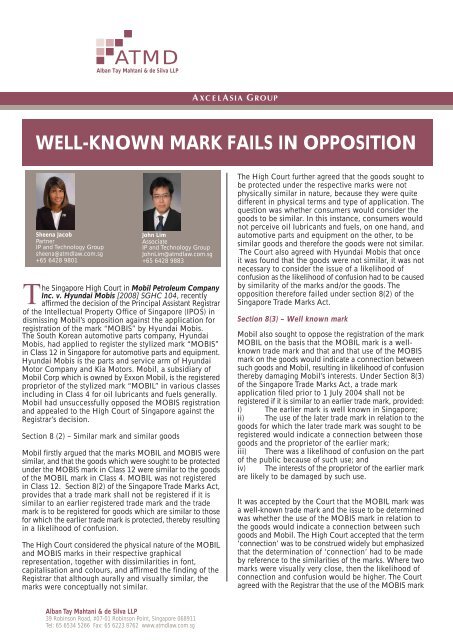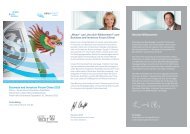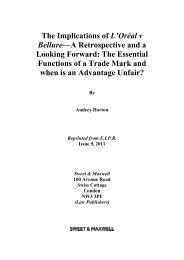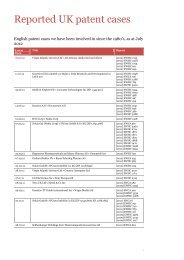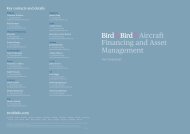ATMD WELL-KNOWN MARK FAILS IN OPPOSITION - Bird & Bird
ATMD WELL-KNOWN MARK FAILS IN OPPOSITION - Bird & Bird
ATMD WELL-KNOWN MARK FAILS IN OPPOSITION - Bird & Bird
You also want an ePaper? Increase the reach of your titles
YUMPU automatically turns print PDFs into web optimized ePapers that Google loves.
<strong>ATMD</strong><br />
Alban Tay Mahtani & de Silva LLP<br />
<strong>WELL</strong>-<strong>KNOWN</strong> <strong>MARK</strong> <strong>FAILS</strong> <strong>IN</strong> <strong>OPPOSITION</strong><br />
Sheena Jacob<br />
Partner<br />
IP and Technology Group<br />
sheena@atmdlaw.com.sg<br />
+65 6428 9801<br />
John Lim<br />
Associate<br />
IP and Technology Group<br />
JohnLim@atmdlaw.com.sg<br />
+65 6428 9883<br />
Taffirmed<br />
the decision of the Principal Assistant Registrar<br />
he Singapore High Court in Mobil Petroleum Company<br />
Inc. v. Hyundai Mobis [2008] SGHC 104, recently<br />
of the Intellectual Property Office of Singapore (IPOS) in<br />
dismissing Mobil’s opposition against the application for<br />
registration of the mark “MOBIS” by Hyundai Mobis.<br />
The South Korean automotive parts company, Hyundai<br />
Mobis, had applied to register the stylized mark “MOBIS”<br />
in Class 12 in Singapore for automotive parts and equipment.<br />
Hyundai Mobis is the parts and service arm of Hyundai<br />
Motor Company and Kia Motors. Mobil, a subsidiary of<br />
Mobil Corp which is owned by Exxon Mobil, is the registered<br />
proprietor of the stylized mark “MOBIL” in various classes<br />
including in Class 4 for oil lubricants and fuels generally.<br />
Mobil had unsuccessfully opposed the MOBIS registration<br />
and appealed to the High Court of Singapore against the<br />
Registrar’s decision.<br />
Section 8 (2) – Similar mark and similar goods<br />
Mobil firstly argued that the marks MOBIL and MOBIS were<br />
similar, and that the goods which were sought to be protected<br />
under the MOBIS mark in Class 12 were similar to the goods<br />
of the MOBIL mark in Class 4. MOBIL was not registered<br />
in Class 12. Section 8(2) of the Singapore Trade Marks Act,<br />
provides that a trade mark shall not be registered if it is<br />
similar to an earlier registered trade mark and the trade<br />
mark is to be registered for goods which are similar to those<br />
for which the earlier trade mark is protected, thereby resulting<br />
in a likelihood of confusion.<br />
The High Court considered the physical nature of the MOBIL<br />
and MOBIS marks in their respective graphical<br />
representation, together with dissimilarities in font,<br />
capitalisation and colours, and affirmed the finding of the<br />
Registrar that although aurally and visually similar, the<br />
marks were conceptually not similar.<br />
Alban Tay Mahtani & de Silva LLP<br />
39 Robinson Road, #07-01 Robinson Point, Singapore 068911<br />
Tel: 65 6534 5266 Fax: 65 6223 8762 www.atmdlaw.com.sg<br />
The High Court further agreed that the goods sought to<br />
be protected under the respective marks were not<br />
physically similar in nature, because they were quite<br />
different in physical terms and type of application. The<br />
question was whether consumers would consider the<br />
goods to be similar. In this instance, consumers would<br />
not perceive oil lubricants and fuels, on one hand, and<br />
automotive parts and equipment on the other, to be<br />
similar goods and therefore the goods were not similar.<br />
The Court also agreed with Hyundai Mobis that once<br />
it was found that the goods were not similar, it was not<br />
necessary to consider the issue of a likelihood of<br />
confusion as the likelihood of confusion had to be caused<br />
by similarity of the marks and/or the goods. The<br />
opposition therefore failed under section 8(2) of the<br />
Singapore Trade Marks Act.<br />
Section 8(3) – Well known mark<br />
Mobil also sought to oppose the registration of the mark<br />
MOBIL on the basis that the MOBIL mark is a wellknown<br />
trade mark and that and that use of the MOBIS<br />
mark on the goods would indicate a connection between<br />
such goods and Mobil, resulting in likelihood of confusion<br />
thereby damaging Mobil’s interests. Under Section 8(3)<br />
of the Singapore Trade Marks Act, a trade mark<br />
application filed prior to 1 July 2004 shall not be<br />
registered if it is similar to an earlier trade mark, provided:<br />
i) The earlier mark is well known in Singapore;<br />
ii) The use of the later trade mark in relation to the<br />
goods for which the later trade mark was sought to be<br />
registered would indicate a connection between those<br />
goods and the proprietor of the earlier mark;<br />
iii) There was a likelihood of confusion on the part<br />
of the public because of such use; and<br />
iv) The interests of the proprietor of the earlier mark<br />
are likely to be damaged by such use.<br />
It was accepted by the Court that the MOBIL mark was<br />
a well-known trade mark and the issue to be determined<br />
was whether the use of the MOBIS mark in relation to<br />
the goods would indicate a connection between such<br />
goods and Mobil. The High Court accepted that the term<br />
‘connection’ was to be construed widely but emphasized<br />
that the determination of ‘connection’ had to be made<br />
by reference to the similarities of the marks. Where two<br />
marks were visually very close, then the likelihood of<br />
connection and confusion would be higher. The Court<br />
agreed with the Registrar that the use of the MOBIS mark
would not indicate a ‘connection’ between those goods<br />
and Mobil, because the resemblance between the marks<br />
was limited by the differences in their font, capitalization<br />
and colour.<br />
The opposition under Section 8(3) of the Singapore<br />
Trade Marks Act therefore failed as the requirement of<br />
a ‘connection’ was not established. The Court therefore<br />
did not find it necessary to determine whether the other<br />
factors in Section 8(3) were established as the Court.<br />
Section 8(4) – Passing off<br />
<strong>ATMD</strong><br />
Alban Tay Mahtani & de Silva LLP<br />
Mobil similarly did not succeed on the ground of<br />
opposition that the registration of a mark is liable to be<br />
prevented by the law of passing off in view of the<br />
findings of the High Court that the goods were not<br />
similar and that there was no connection or confusion.<br />
Mobil’s opposition under Section 8(4) of the Singapore<br />
Trade Marks Act, which provided that a trade mark shall<br />
not be registered, if its use in Singapore is liable to be<br />
prevented by virtue of the law of passing off, was<br />
unsuccessful, as the Court had already decided that<br />
there was a limited degree of resemblance between the<br />
marks and no connection between the goods of the<br />
Alban Tay Mahtani & de Silva LLP<br />
39 Robinson Road, #07-01 Robinson Point, Singapore 068911<br />
Tel: 65 6534 5266 Fax: 65 6223 8762 www.atmdlaw.com.sg<br />
MOBIS mark and Mobil existed. There was therefore no<br />
basis on which the Court could establish an actionable<br />
misrepresentation.<br />
Section 7(6) – Bad faith<br />
The opposition to the registration of the MOBIS mark<br />
on the basis that the application was made in bad faith<br />
under Section 7(6) of the Singapore Trade Marks Act<br />
was also unsuccessful. The High Court held that the<br />
burden lay on Mobil to prove that the application was<br />
made in bad faith, and Mobil had not adduced evidence<br />
to substantiate its allegation. The two marks were not<br />
so close as to lead to an inference of bad faith. The<br />
High Court accepted Hyundai Mobis’ explanation of<br />
how the mark Mobis came to be derived and in the<br />
absence of evidence was not prepared to make a finding<br />
of bad faith.


